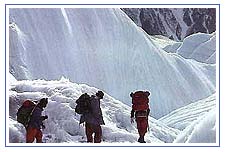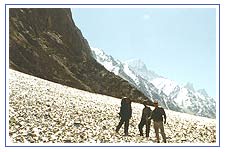
The
Himalayas are known for its adventure sports and activities in the world
that range from trekking, camping, kayaking, fishing, angling, hand
gliding and many more and is truly a adventurers paradise.
Duration: 06 Nights - 07 Days
Duration: 07 Nights - 08 Days
Duration: 08 Nights - 09 Days
Duration: 09 Nights - 10 Days
Duration: 11 Nights - 12 Days
Duration: 05 Nights - 06 Days
Mountaineering
| Major
Regions: |
India & Nepal
Himalayas |
| Famous Peaks: |
Mount Everest,
Kanchenjunga, Annapurna, K2, Nanda Devi |
| Higest Altitude: |
8,848m |
| Best Season: |
April To November &
December To March |
|
Click Here for
Mountaineering
Tours |
The Call Of The Mountains

The
lure of Himalayas is irresistible for the mountaineers, as the Himalayas are
the greatest range of mountains on earth, their beauty, vastness,
fascination and mystery will always have an everlasting appeal for those who
venture in this region.
The Himalayas, by humbling those that come to them with its magnitude and
power, gratifying them with its splendour and beauty, testing their
determination by glaciers and peaks, defying their spirit with their
inviolate mysteries-enables man to acquire the qualities which only danger
and nature in the raw can sharpen. Mountaineering accentuates and exercises
the quality of self-reliance, leadership and discipline amongst adventure
sports lovers.
Mountaineering Institutes & Adventure Sports Clubs
The conquest of
Everest acted as a stimulus to Indian mountaineering and in 1954, the
Himalayan Mountaineering Institute at Darjeeling was established with the
late major N.D. Jayal (Nandu) as its first principal. Since then other
institutes have been set up at Uttarkashi in Uttaranchal and at Manali in
Himachal Pradesh.
In addition to these three institutes, there are a number of small
institutions and clubs all over India where short courses on rock climbing
etc are available. Basic courses in mountaineering are devoted to
theoretical training-consisting of lectures on high altitude physiology,
history of mountaineering, mountain fauna and flora, geomorphology, geology,
map reading and glaciology.
During the course, films on wildlife, mountaineering expeditions, and
allied subjects are shown. The practical side is covered by treks where
training on rock, snow and ice is given. This period culminates with a climb
to a peak of 5,490m and 6,100m as part of the advanced course, expeditions
are organised to peaks such as Kamet, Trisul, etc..
Cautions While Mountaineering & Ice Climbing
One
widespread fallacy that constitutes an obstacle to the growth of climbing is
the general impression that it is a very dangerous sport. It is true that
climbing carrier with it certain risks and it is a fact that lives can be
lost and have been lost in the mountains. Nevertheless, it is equally true
that for an experienced climber who takes the normal precautions, the margin
of risk is very much less than what popular imagination would seem to accord
it.
Many climbing accidents occur because of inexperience people taking
insufficient precautions. The potential for the advancement of Indian
mountaineering in the future is great. As roads penetrate the Himalayas and
bring the peaks ever closer to the plains, as the enthusiasm of the pioneers
spreads to more and more people, it is difficult to believe that at least
some part of the potential will not be realised.
While the equipment of a climber is of great importance, the individual
equipment - both mental and physical fitness of the mountaineer, is of even
greater importance. One slip or thoughtless action may turn the joy of the
heights into the sorrow of the depths. Good judgment, constant care and
teamwork are indispensable items in the climbers' outfit.
Mountaineering In Himalayas

Getting
to the Himalayas is difficult they are far away from most of the people and
difficult to get go. A big obstacle is the expense. The actual time spent on
the climbing is relatively a small proportion of the total time taken by the
mountaineer to get to the mountain. It is an expedition with Sherpas
carrying loads of equipment, such as tents, sleeping bags, cooking utensils
etc. Of course, costs can be reduced if equipments can be hired and one
organises climbs and tours through mountaineering clubs and societies.
Mountaineering Sites In The Himalayas
Mountaineering In
Ladakh, J&K:
The Suru and Zanskar valleys provide some of the more spectacular and
difficult climbing in Ladakh. The Nun Kun Massif is one of the most frequent
climbing areas of the region and is booked out for months ahead, sometimes
years, by climbing expeditions. The approach to the twin peaks is from the
Kargil-Padum Road, about 70-km south of Kargil. The main approach is either
from Tangole or Gulmadong. Some expeditions have also approached from
Parkutse along the Kangri Glacier. To reach the base camp for Kun it is for
the climbers necessary to cross the Suru River.
Pir Panjal mountaineering range is situated south of the Himalayas. The
vale of Kashmir is sandwiched between the Pir Panjals and the Himalayas.
Similarly the Lahaul valley, north of Manali and south of Ladakh, is
sandwiched between the two ranges.
Mountaineering In
Manali,
Himachal Pradesh:
The area around Manali presently forms the core of mountaineering in
Himachal. The Beas Kund region and lower reaches of the Hanuman Tibba
(5,930m), the Manali and Shitidhar peaks around the source of the river
Beas, and the Deo Tibba (6,001m) area, are suggested for beginners with some
experience.
Mountaineering In
Garhwal
& Kumaon Himalayas, Uttaranchal:
The Garhwal and Kumon region in the state of Uttaranchal not only
constitutes a large part of the Himalayas, but also contains some of the
most challenging peaks - Nanda Devi, Trisul, Dunagiri, Kamet, Chaukhamba,
Nilkanth, Bandarpoonch, etc.
 Mounatineering In
Sikkim Himalayas:
Mounatineering In
Sikkim Himalayas:
The Sikkim Himalayas, the epitome of the world's mountains, encompass a
wonderland, which for sheer beauty and magnificence remains unbeaten
elsewhere in the globe. In the southwestern part of Sikkim, in the main
Himalayan range, lies the majestic Kanchendzonga or Kanchenjunga, rising to
a staggering height of 8,585 m (28,169 ft) above sea level. Beside this
third largest peaks, other famous mountaineering peaks in Sikkim include -
Kabru, Kirat Chulior Tent Peak (7,365 m) and Sinolchu (6,887 m).
Mountaineering In
Nepal:
The Everest or Khumbu region is justifiably the most famous of all trekking
and mountaineering regions of Nepal. Populated by Sherpas, the attractions
of this area are the majestic mountains, the high mountain villages, the
isolated monasteries, and the local peoples. This area includes the highest
mountain in the world, Everest at 8,848m, and many of the world's 8,000m
peaks such as Lhotse, Cho Oyu, and Makal.
Mounatineering In
Tibet:
Even if Tibet is new to the mountaineering and adventure sport circuit,
still if you like to explore the unexplored visit this cold desert land.
Tibetan mountaineering associations have been issuing permits to foreign
climbers for mount Everest and twenty other summits. The majority of these
mountains are part of the high Himalayas between Everest and Shishapangma,
though several other interesting 7,000m and 6,000 peaks have been opened on
other regions of Tibet.
Mountaineering In
Bhutan:
Just like Tibet, mountaineering in the Bhutanese Himalayas is a recent
development . Bhutan is one of the most exclusive and rare destinations for
any tourist. The unique culture, architecture, lofty snowcapped peaks,
fortress like "Dzongs", Lamaist Buddhist traditions and its
friendly people leave an everlasting impression on the visitor. Almost all
the trekking and mountaineering expeditions in Bhutan range above 3,000m.
Ecological Balance
The call of
the mountains is growing, and it will always be there if the basic character
of mountains does not suffer a setback. Much harm can be done to the
mountains if mountaineers and trekkers do not take adequate measures to
preserve the ecological balance. Forests not only make mountains. The
mountaineers and trekkers will do well in saving the green trees. Then the
litter from the camps needs to be collected and properly dumped and
destroyed. The wild life should not to be disturbed at all. These are some
important codes of conduct, which the mountaineers should enforce strictly.






 The
lure of Himalayas is irresistible for the mountaineers, as the Himalayas are
the greatest range of mountains on earth, their beauty, vastness,
fascination and mystery will always have an everlasting appeal for those who
venture in this region.
The
lure of Himalayas is irresistible for the mountaineers, as the Himalayas are
the greatest range of mountains on earth, their beauty, vastness,
fascination and mystery will always have an everlasting appeal for those who
venture in this region.  Getting
to the Himalayas is difficult they are far away from most of the people and
difficult to get go. A big obstacle is the expense. The actual time spent on
the climbing is relatively a small proportion of the total time taken by the
mountaineer to get to the mountain. It is an expedition with Sherpas
carrying loads of equipment, such as tents, sleeping bags, cooking utensils
etc. Of course, costs can be reduced if equipments can be hired and one
organises climbs and tours through mountaineering clubs and societies.
Getting
to the Himalayas is difficult they are far away from most of the people and
difficult to get go. A big obstacle is the expense. The actual time spent on
the climbing is relatively a small proportion of the total time taken by the
mountaineer to get to the mountain. It is an expedition with Sherpas
carrying loads of equipment, such as tents, sleeping bags, cooking utensils
etc. Of course, costs can be reduced if equipments can be hired and one
organises climbs and tours through mountaineering clubs and societies.
